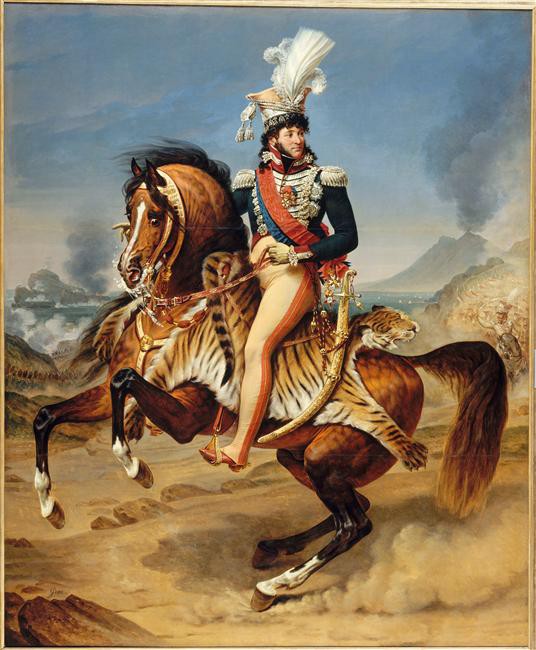I. What can we see in this picture?
When Joachim Murat asked the painter Antoine-Jean Gros to make this very large portrait in 1811 (the painting measures 3m43 by 2m80!), he had already been the King of Naples for three years (1808) and wanted the picture to demonstrate his triumphal success. To illustrate the kingdom, the painter chose to show the famous volcano Vesuvius, with a billow of smoke floating up into the sky (background, right). Being an excellent rider, Joachim Murat is shown astride a rearing horse that he mastered perfectly. He is wearing a shiny uniform and carries in his belt a richly decorated sabre. But in particular, the painter highlights some eccentricities of Joachim Murat such as the feathers on his hat – called a chapka – and the panther skin in place of a saddle, which are suggestive of Murat’s original taste. This painting is now in the Louvre.
II. Who was Joachim Murat?
The great military man
Murat was born in La Bastide-Fortunière – known today as Labastide-Murat in a region called the Lot in the southwest of France – on 25 March 1767. He was of very humble origins, his father was a simple innkeeper. Thanks to his bravery, he slowly climbed up the military ladder, becoming General on 25 July, 1799, during the battle of the Nile in the Egyptian campaign. Oriental details of the painting are reminiscent of this past: the tigerskin and the curved sabre like those of the Turks. He became a Marshal in 1804, and participated in every major battle of Napoleon’s campaigns, including Austerlitz (1805), Jena (1806), Eylau (1807) and Borodino (1812). Napoleon considered him a brave soldier although sometimes too impulsive and reckless.
Napoleon’s brother-in-law
Joachim Murat was not, however, one of the Emperor’s highest-ranking military officers. Shortly after his return from Egypt in 1800, he married Caroline Bonaparte, Napoleon’s youngest sister. They had four children together: Achilles, Laetizia, Lucien and Louise. As a member of the family, Joachim Murat was made prince, then Grand Duke of Berg and Cleves, on 30 March 1806. Then he was made King of Naples, under the title of Joachim Napoleon on 15 July 1808. Caroline reigned as Queen with her husband but their visions of politics often diverged. The couple was also not always on very good terms with Napoleon himself, either!
The sad end of Joachim Murat
Murat wanted to be more independent from Napoleon and after the failure of the German campaign in 1813, he was convinced that Napoleon’s Empire was over. He then tried to negotiate with Austria for a separate peace settlement for his kingdom. Many of the Emperor’s faithful supporters would never forgive this betrayal. However , as the events accelerated after the campaign in Germany and then in France, and Napoleon was sent into a first exile on the Mediterranean island of Elba in 1814, the two brothers-in-law would soon send each other secret letters. When Murat learnt that Napoleon was back in France after fleeing Elba to regain power (this period would be known as the “Hundred Days”), he attempted to reach out and break his alliance with Austria. But he rashly invaded the Pope’s territories (to the north of Naples) because that was the quickest way to return to France. The Pope felt threatened and fled. Murat also tried to encourage a revolutionary movement in Italy in order to create a single state gathering all Italians in a kingdom that he would lead. The allied foreign powers united against Napoleon, with Austria as their leader, then decided to put a stop to Murat’s plans. On 2 and 3 May the battle of Tolentino took place which would mark the defeat of Murat in Italy. He would never arrive in time for the Battle of Waterloo, on 18 June 1815. After the final fall of the Empire, Murat first went into hiding in Corsica, then he tried to return to encourage a revolution in Italy but this plan failed. He was taken prisoner there, in the town of Pizzo and was executed on October 13, 1815. His body was never found.
(Marie de Bruchard, September 2015)


